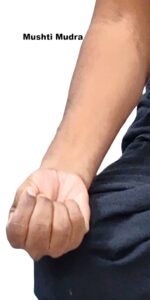Mushti Mudra
Introduction
Mushti Mudra is one of the fundamental Hasta Mudras (hand gestures) in yoga and Ayurveda. The word Mushti means “fist” in Sanskrit. This mudra involves closing the fingers into a fist, symbolizing the expression and release of suppressed emotions, particularly anger, frustration, or resentment. It is often called the “Fist Gesture” and is used to stimulate digestion, release inner tension, and harmonize emotional imbalances.
It is both a therapeutic and symbolic mudra, representing strength, determination, and emotional release.
Meaning
Mushti = Fist, clenching
Mudra = Gesture, seal
Thus, Mushti Mudra symbolizes the clenching and letting go of inner negative energy, bringing balance to body and mind.
How to Perform Practice
Sit in a comfortable meditative posture (Sukhasana, Padmasana, or even on a chair with a straight spine).
Relax the shoulders and keep the hands on the thighs.
Slowly fold the fingers inward to form a gentle fist.
Place the thumb over the folded fingers (without too much tightness).
Rest the fists facing upward on the thighs.
Close the eyes, breathe deeply, and focus on exhaling stress and negativity.
Practice for 5–15 minutes, once or twice daily.
Benefits
Physical Benefits
Stimulates digestion and relieves constipation.
Balances Pitta dosha (fire element).
Relieves headaches caused by suppressed anger.
Reduces bloating and improves metabolic activity.
Can help reduce fatigue and lethargy.
Mental & Emotional Benefits
Helps release anger, irritation, and frustration.
Brings emotional balance by calming the mind.
Provides a healthy outlet for suppressed emotions.
Induces relaxation and stress relief after emotional outbursts.
Spiritual Benefits
Symbolizes the power of transformation (holding and releasing).
Enhances willpower and determination.
Connects practitioner with inner strength.
Contraindications
People with very high blood pressure should avoid long practice, as fist formation may increase tension.
Those with arthritis or hand injuries should keep the fist loose and avoid strain.
Not recommended for prolonged use in people with excess heat-related issues (ulcers, high Pitta).
Anatomy & Physiology
Compresses and stimulates nerve endings in the palms and fingers.
Activates the manipura chakra (solar plexus), regulating digestion and metabolic fire.
Encourages release of hormones related to stress management.
Improves circulation in the forearms and hands.
Kinesiology
Uses flexor muscles of the forearm (flexor digitorum profundus, flexor digitorum superficialis).
Engages intrinsic hand muscles (lumbricals, interossei).
Involves the thumb flexors for sealing the mudra.
Strengthens grip and enhances coordination of finger flexors.
Neurology
Activates the somatosensory cortex linked to hand movement.
Stimulates parasympathetic nervous system → emotional relaxation.
Triggers release of neurotransmitters (serotonin, dopamine) through stress release.
Enhances brain-gut axis communication via vagus nerve stimulation (benefiting digestion).
Duration of Mudra
General practice: 5–15 minutes, 2–3 times daily.
For digestive problems → 10 minutes before meals.
For emotional release → whenever anger or frustration arises.
Counter Mudra
Apana Mudra → for grounding and detoxification.
Gyan Mudra → for mental clarity after emotional release.
Prana Mudra → for recharging energy after stress release.
Conclusion
Mushti Mudra is a powerful hand gesture symbolizing the process of clenching and releasing—both physically and emotionally. It improves digestion, reduces anger, and balances emotional energy. By practicing it regularly, one learns to channel inner strength while letting go of negative energies. It is a holistic practice for digestive health, emotional stability, and spiritual grounding.
FAQ
Q1: Can Mushti Mudra really help with anger?
Yes, it provides a symbolic and physical outlet for anger, helping to release emotional tension.
Q2: When should I practice Mushti Mudra?
When feeling angry, frustrated, or before meals for digestion.
Q3: Can children practice Mushti Mudra?
Yes, children can use it to calm themselves during irritability or emotional stress.
Q4: Can it be done while standing or walking?
It is best practiced sitting, but can be done anywhere when needed for quick emotional release.
Q5: Does it help in weight loss?
Indirectly, yes—it improves digestion and metabolism, which supports healthy weight management.
References
Swami Satyananda Saraswati – Asana, Pranayama, Mudra, Bandha
Gertrud Hirschi – Mudras: Yoga in Your Hands
Indu Arora – Mudra: The Sacred Secret
Bihar School of Yoga – Publications on Mudra Therapy
Dr. Dhirendra Brahmachari – Yoga Mudra Vigyan
